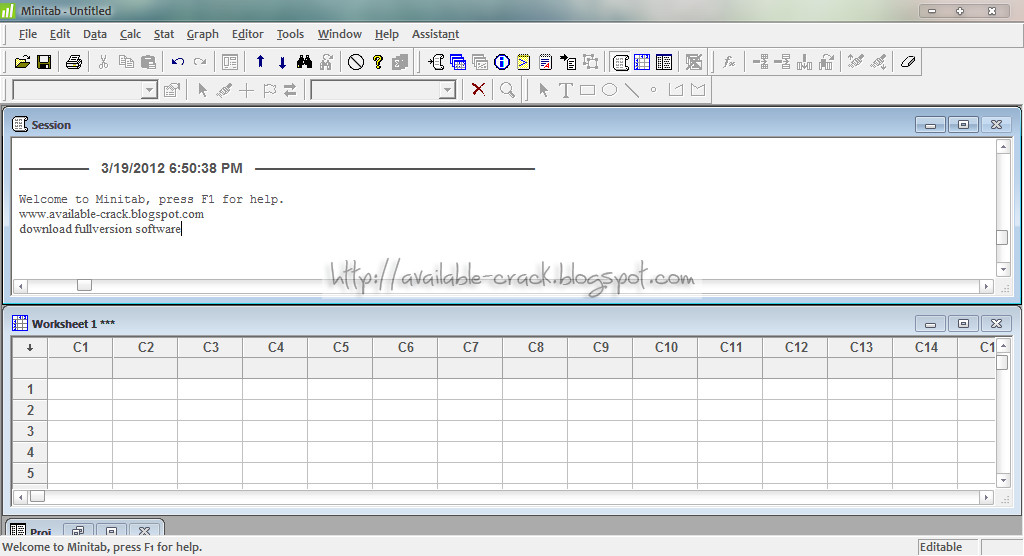

- An introduction to data analysis using minitab 16 how to#
- An introduction to data analysis using minitab 16 software#
- An introduction to data analysis using minitab 16 series#
We learn all these tests in the Minitab Training. We here discuss three methods of calculating process capability, viz., Defects Per Million Opportunities (DPMO), Process Capability Index – Corrected Process Capability Index (Cp & Cpk) and Standard Normal Approximation method.

If our data fits satisfactorily with Normal curve model, then we use this model to calculate Process Capability. So, we check the Normality of our data to understand how much closer it is to the normal curve model. We need to fit our data into a statistical model. And also we arrive at a sampling size and sampling methodology, do collect data, we screen the data for errors – trends and patterns, typo-errors, the stability of process to validate that collected data represent the process. Hence, we use Measurement System Analysis to check the reliability of our data sources. We need to be doubly sure that our data is reliable. In this phase, the real world problem gets converted into a statistical problem which is easier to solve. In Measure Phase, the defined problems are measured in terms of statistics. In DMAIC methodology, the problem is defined in the first phase. Because Six Sigma is an investigative problem-solving methodology and Statistical Data Analysis is the backbone of Six Sigma. This Minitab Training is designed as per DMAIC structure of Six Sigma. Statistical Data Analysis: Minitab Training Statistics and DMAIC
An introduction to data analysis using minitab 16 how to#
Let’s understand how to conduct Statistical Data Analysis using Minitab effectively. Minitab provides a quick, effective solution for the level of analysis. It is also extensively used by Six Sigma Experts a is an important part of studying data, particularly in the Measure and Analyse phases of DMAIC.
An introduction to data analysis using minitab 16 software#
Minitab is a software package that helps us in the analysis of data. The Minitab Data Analysis program is structured on Six Sigma’s DMAIC framework. This program covers basic statisitical theories and tools along with Minitab tools and application. Minitab Training will help you understand statistics and data analysis and give you hands-on Minitab Software. To learn more about the specialization, check out a video overview at. Lessons feature case studies highlighting ROI achieved through DDDM, and the cultural changes required for success. Content touches on leadership’s role in instituting an internet of things (IoT) strategy in manufacturing and service environments. Course topics include analyzing process maps for driving improvement, software for maximizing data analysis, statistical process control, creating metrics dashboards and translating data stories, and the connection between operations technology metrics and organizational performance.
An introduction to data analysis using minitab 16 series#
The three-course series explores how technology enables the collection and organization of unprecedented amounts of data, and how to dissect that data to gain powerful insights. This specialization explains why it is important to leverage data when contemplating organizational choices, and supplies the tools at the heart of data-driven decision making (DDDM). It is the second course in the Data-Driven Decision Making (DDDM) specialization. It is helpful if learners have some familiarity with reading reports, gathering and using data, and interpreting visualizations. This course is ideal for individuals keen on developing a data-driven mindset that derives powerful insights useful for improving a company’s bottom line. Material features online lectures, videos, demos, project work, readings and discussions.

The course also addresses do’s and don’ts of presenting data visually, visualization software (Tableau, Excel, Power BI), and creating a data story. Deeper examination is spent on statistical process control (SPC), which is a method for studying variation over time. It begins with common hurdles that obstruct adoption of a data-driven culture before introducing data analysis tools (R software, Minitab, MATLAB, and Python). By the end of this course, learners are provided a high-level overview of data analysis and visualization tools, and are prepared to discuss best practices and develop an ensuing action plan that addresses key discoveries.


 0 kommentar(er)
0 kommentar(er)
